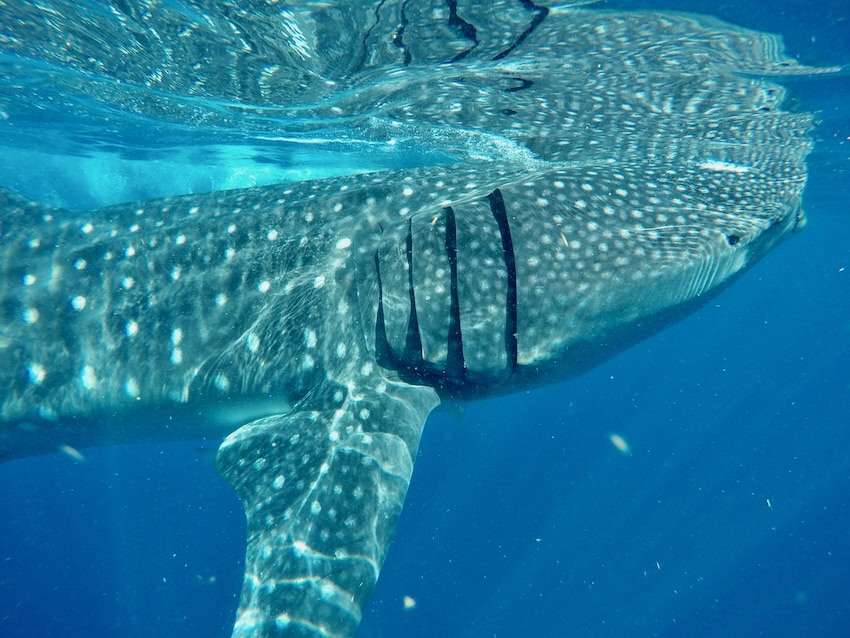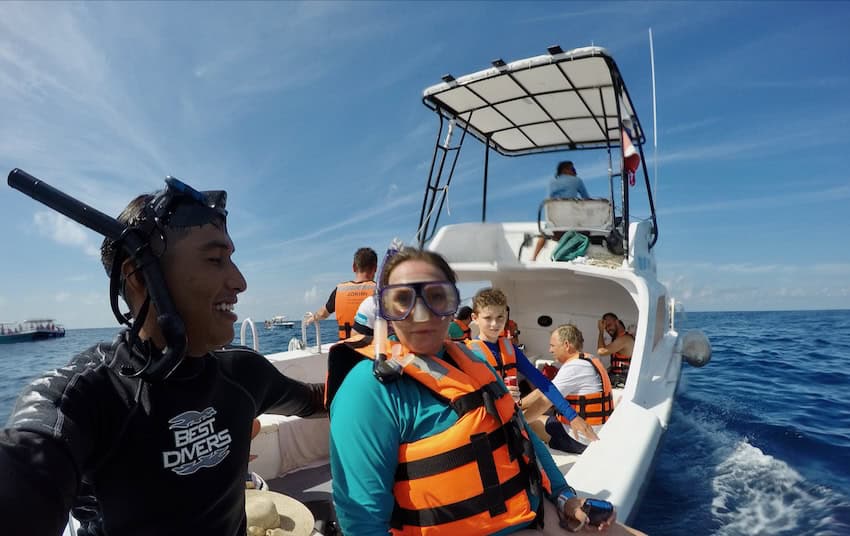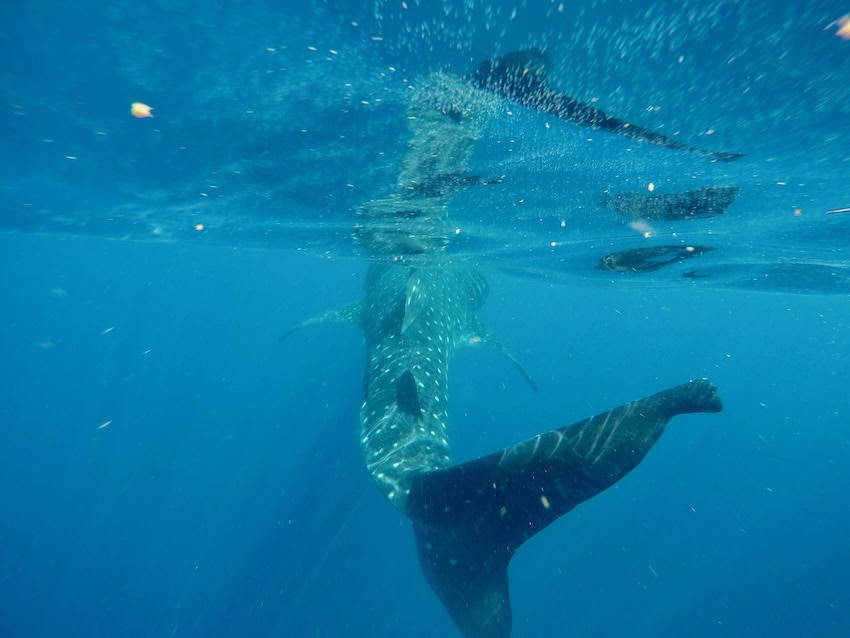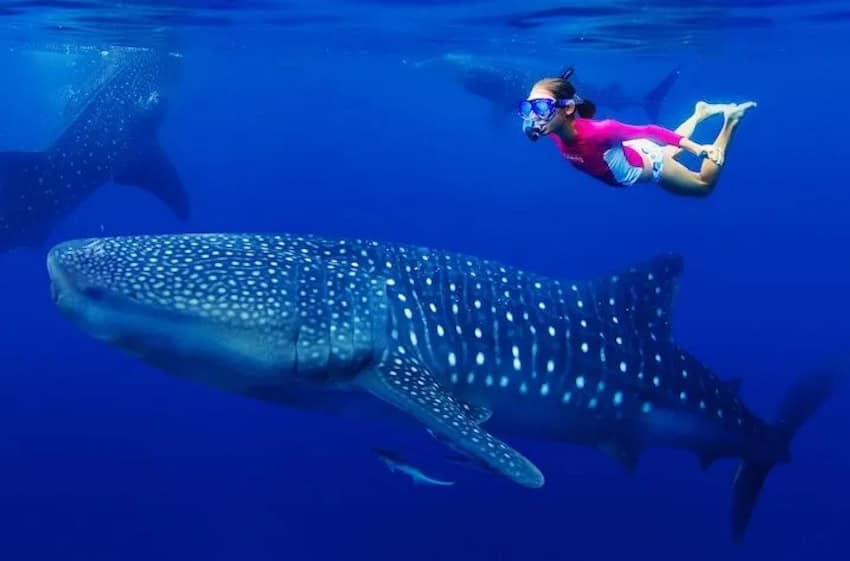Swimming with whale sharks in Cancún

This adventure had been on my bucket list for years. For all the years I’ve lived in Mexico, I couldn’t wait to be swimming with whale sharks in Cancún. Ever since I first saw a photo of one on the covers of National Geographic, it was love at first sight. What can I say … I’m a water baby!
If I’m honest, it’s why I live in the Riviera Maya. The crystal clear Caribbean waters are stunning. So I was delighted when we found these gentle giants off the northern tip of Isla Mujeres. A mere 25 minutes after leaving Cancún, my lifelong dream came true. I found myself staring down at one as it went silently glide past.

The size was astounding.
So, how big are whale sharks?
Bigger than I thought. The first one was the length of our boat. The second one was a little smaller but still breathtakingly impressive.
Staring down through the crystal clear water was beautiful satiny dark skin mottled with white spots. The enormous gaping mouth sucked in everything in its path. My friend next to me sucked in her breath seeing this. But it’s okay, it’s not dangerous, being filter feeders, that’s how they feed.
And did that huge mouth deter me from wanting to jump in? No, not at all. I knew I wasn’t on the menu.
Okay, bear with me while I geek out on fun facts so you know how harmless they are!
All about whale sharks: Do they have teeth? What do whale sharks eat?
Fun whale shark fact time: Whale sharks are harmless. Even though they have 3,000 teeth. Teeny tiny teeth. In fact, they are so tiny they’re not visible, so they do not bite or chew. Whale sharks are filter feeders. That means they filter small animals from the water. Zooplankton and phytoplankton, as well as krill, jellyfish, and tiny crab larvae are favorites. Occasionally, small fish get sucked in too.


This is why they are so close to the surface. The warm top layer of water is where the plankton live. With their huge mouths open, this feeding behavior is called ram-filtration. It channels the plankton-filled water into their mouths, where it’s strained. The shark’s gills have a fine mesh called gill rakers, which catch the plankton.
That’s why they’re so great to swim with. They’re close to the surface, so you don’t have to dive. They aren’t predatory, so you’re safe. And best of all, they cruise at a steady speed. It’s quite a fast speed, though, so grab your fins!
Swimming with the whale sharks
I’ll say this, whale sharks swim deceptively fast. I consider myself a good swimmer. I live in Cozumel in the Mexican Caribbean and swim all the time, usually 2-3 km at a time. Plus, I’m ex-Navy and have had to maintain my swimming fitness year-round for years.
I don’t say this to brag. I say this to give you a point of reference. These gentle giants cruise a lot faster than I thought. They seem to glide along effortlessly. But that massive tail sure does give maximum propulsion for little effort.
My friend, who was with me, missed it the first couple of times. By the time she jumped in and started swimming, it was gone. Nothing but tail when she looked up.
Thankfully, I learned from that. I swung my legs over the side of the boat and jumped in as the shark approached. The trick is to start swimming strongly before you hit the surface. Otherwise, it just cruises by while you pop to the surface.
Still, it was a heart-pumping exercise. I had to jump in and swim like an Olympian. I couldn’t keep up that pace for long. But this enabled me to get some beautiful pictures and videos as they glided by. And left me feeling very small as that big tail slowly disappeared in the distance.
How big is a whale shark?


More fun whale shark facts. Whale sharks are the largest fish in existence. Yes, that’s right. A mature 12-meter-long whale shark can weigh eleven tons. And their mouth can be over a meter wide. Let me tell you, up close, it’s breathtaking!
So, when you see more than one close to you, it’s thrilling. Usually, whale sharks are solitary creatures cruising the seas alone. But each year, they gather in this area between Isla Mujeres and Holbox Island to feast in the plankton-rich water.
When is the best time to swim with whale sharks?
From June to September each year is best. The plankton-rich currents from South America reach the Gulf of Mexico. Meeting the warm Caribbean Sea makes a very rich feeding ground for whale sharks.
Is it worth swimming with whale sharks?
As I said at the start, this was on my bucket list. Swimming alongside the largest fish on earth…for me, was priceless. It’s a once-in-a-lifetime kind of adventure you will tell your grandkids about.
Having said that, many of the people on our trip couldn’t keep up. While thrilled at seeing the sharks, they were a little disappointed.
So, my advice is this. Get back in the water before you go. Not like you’re training for an Ironman. No, just to feel comfortable in the water. That way, you will keep up and create a lifelong memory.
Mexico Correspondent for International Living, Bel is an experienced writer, author, photographer and videographer with 500+ articles published both in print and across digital platforms. Living in the Mexican Caribbean for over 7 years now she’s in love with Mexico and has no plans to go anywhere anytime soon.
Source: Mexico News Daily

